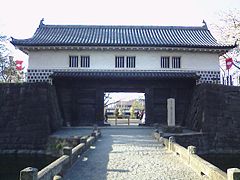Shibata Castle
| Shibata Castle | ||
|---|---|---|
|
Gosangai watchtower |
||
| Creation time : | 13th Century | |
| Castle type : | Hirajiro (Lower Castle) | |
| Conservation status: | Partly reconstructed | |
| Place: | Shibata | |
| Geographical location | 37 ° 57 '19.7 " N , 139 ° 19' 31.5" E | |
|
|
||
The Castle Shibata ( Japanese 新発田城 , Shibata-jō ) is located in the city of Shibata , Niigata Prefecture . In the Edo period , the Mizoguchi resided there continuously , who with an income of 60,000 koku belonged to the smaller Tozama daimyo .
history
Shibata Castle was built in the Kamakura period by a branch of the Sasaki-Genji who called themselves Shibata. In the Sengoku period Shibata Shigeie ( 新 発 田 重 家 ; 1547–1587), a member of the Agakita group who made contact with Oda Nobunaga , was killed by his opponent Uesugi Kagekatsu (1565–1623). In 1598 Mizoguchi Hidekatsu ( 溝口 秀 勝 ; 1548–1610) with an income of 60,000 Koku took over the fiefdom, initially lived in Ijimino ( 五十 公 野 ) and set about repairing the castle and creating the samurai quarters. However, the completion took three generations until 1654.
Around the center of the castle, the Hommaru, was surrounded by the "inner moat" ( 内 堀 , Uchibori ). The Hommaru was protected by walls and by the Tatsumi watchtower, the Teppō watchtower ( 鉄 砲 櫓 ) and the three-story Gosangai watchtower ( 御 三階 櫓 ). The latter took over the function of the castle tower ( 天 守 閣 , Tenshukaku ). The other castle districts, the Ni-no-maru and the San-no-maru, were laid out around it. The prince's closest collaborators lived in these districts. On the north side of the Hommaru, part of the Ni-no-maru Furu-maru ( 古 丸 , "old enclosure") was called. It is said to have been the remains of the previous castle. The “Outer Trench” ( 外 堀 , Sotobori ) used an old tributary of the Shibata River.
In 1668, a major fire destroyed most of the buildings, and the following year an earthquake damaged the stone and earth walls. By 1700 the castle was largely restored.
After the castle was abandoned in the course of the Meiji restoration in 1868, only the “front gate” ( 丸 表 門 ) of the Hommaru and the watchtower in front of the Ni-no-maru remained. Only the southern and western parts of the inner ditch remained, the northern part became the barracks area. To the south of it, a small part of the Ni-no-maru became a park. In recent years the Gosangai and Tatsumi watchtowers have been restored.
photos
Remarks
- ↑ The Agakita Group ( 揚 北 衆 , Agakita-shū ) was an association of large landowners in the area.
- ↑ Tatsumi ( 巽 or 辰 巳 ) is the southeast corner of the castle after the Twelve Earth Branches .
literature
- Ikeda, Kōichi: Shibata-jo in: Miura, Masayuki (Ed.): Shiro to jinya. Tokoku-hen. Gakken, 2006. ISBN 978-4-05-604378-5 , p. 100.
- Miyaji, Saichiro (Ed.): Bakumatsu shoshu saigo-no hanshu-tachi. Higashinihon-hen. Jinbunsha, 1997. ISBN 978-4-7959-1905-1 .





